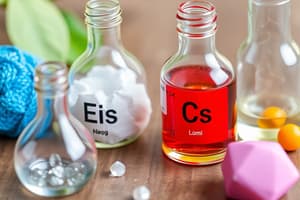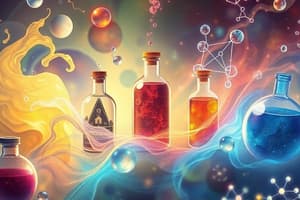Podcast
Questions and Answers
Which statement accurately describes the properties of a solid?
Which statement accurately describes the properties of a solid?
- Solids only exist in high-pressure environments.
- Solids have both a definite shape and volume. (correct)
- Solids can flow and conform to the shape of their container.
- Solids have no definite shape and take the form of their container.
What characteristic defines a compound?
What characteristic defines a compound?
- It retains the properties of the original elements.
- It can be separated by physical means.
- It consists of only one type of atom.
- It has a fixed ratio of elements chemically combined. (correct)
Which part of an atom has a negative charge?
Which part of an atom has a negative charge?
- Electrons (correct)
- Protons
- Nucleus
- Neutrons
What occurs during a chemical reaction?
What occurs during a chemical reaction?
Which is an example of a homogeneous mixture?
Which is an example of a homogeneous mixture?
What does the atomic number of an element represent?
What does the atomic number of an element represent?
Which type of property describes how a substance reacts with other substances?
Which type of property describes how a substance reacts with other substances?
Which of the following best describes an element?
Which of the following best describes an element?
How are elements organized in the Periodic Table?
How are elements organized in the Periodic Table?
What distinguishes a solution from a mixture?
What distinguishes a solution from a mixture?
Flashcards
What is matter?
What is matter?
Anything that has mass and takes up space.
What are the properties of a solid?
What are the properties of a solid?
Solids have a definite shape and volume.
What are the properties of a liquid?
What are the properties of a liquid?
Liquids have a definite volume but take the shape of their container.
What are the properties of a gas?
What are the properties of a gas?
Signup and view all the flashcards
What is an element?
What is an element?
Signup and view all the flashcards
What is a compound?
What is a compound?
Signup and view all the flashcards
What is an atom?
What is an atom?
Signup and view all the flashcards
What is an atomic number?
What is an atomic number?
Signup and view all the flashcards
What is a mixture?
What is a mixture?
Signup and view all the flashcards
What is a solution?
What is a solution?
Signup and view all the flashcards
Study Notes
Matter and its Properties
- Matter is anything that has mass and takes up space.
- Matter exists in three fundamental states: solid, liquid, and gas.
- Solids have a definite shape and volume.
- Liquids have a definite volume but take the shape of their container.
- Gases have neither a definite shape nor a definite volume; they expand to fill their container.
- Physical properties of matter can be observed or measured without changing the substance's chemical composition. Examples include color, odor, density, melting point, and boiling point.
- Chemical properties describe how a substance reacts with other substances to form new substances. Examples include flammability, reactivity with acids, and tendency to rust.
Elements and Compounds
- Elements are substances that cannot be broken down into simpler substances by chemical means. They are the fundamental building blocks of matter. Oxygen, hydrogen, and carbon are examples of elements. The Periodic Table organizes elements based on their properties.
- Compounds are substances formed by the chemical combination of two or more elements in a fixed ratio. Water (H₂O) and carbon dioxide (CO₂) are examples of compounds. The properties of a compound are different from those of its constituent elements.
Atomic Structure
- Atoms are the basic units of elements. Atoms consist of a nucleus containing protons (positively charged particles) and neutrons (neutral particles). Electrons (negatively charged particles) orbit the nucleus.
- The number of protons in an atom's nucleus defines the element. This is its atomic number.
- The mass of an atom is primarily determined by the number of protons and neutrons.
Mixtures and Solutions
- Mixtures are combinations of two or more substances that are not chemically bonded. Mixtures can be heterogeneous (e.g., sand and water) or homogeneous (e.g., saltwater).
- Solutions are homogeneous mixtures in which one substance (solute) is dissolved in another substance (solvent). A solution is a uniform mixture of particles.
Chemical Reactions
- Chemical reactions involve the rearrangement of atoms to form new substances.
- Essential parts of chemical reactions are reactants and products. Reactants are the substances that undergo a change, and products are the new substances formed.
- Chemical equations are used to represent chemical reactions.
Periodic Table
- The Periodic Table is a chart that organizes all known elements based on their atomic structure and properties.
- Elements in the same column (group) have similar chemical properties.
- Elements in the same row (period) have increasing numbers of electron shells.
Physical Changes
- Physical changes alter the physical properties of a substance without changing its chemical composition. Examples include melting, freezing, boiling, and dissolving.
Chemical Changes
- Chemical changes result in the formation of new substances. Examples include combustion, rusting, and reactions with acids. Energy is often released or absorbed during a chemical change.
Conservation of Mass
- In any chemical or physical change, the total mass of the substances involved remains constant. This is also known as the Law of Conservation of Mass.
Studying That Suits You
Use AI to generate personalized quizzes and flashcards to suit your learning preferences.



